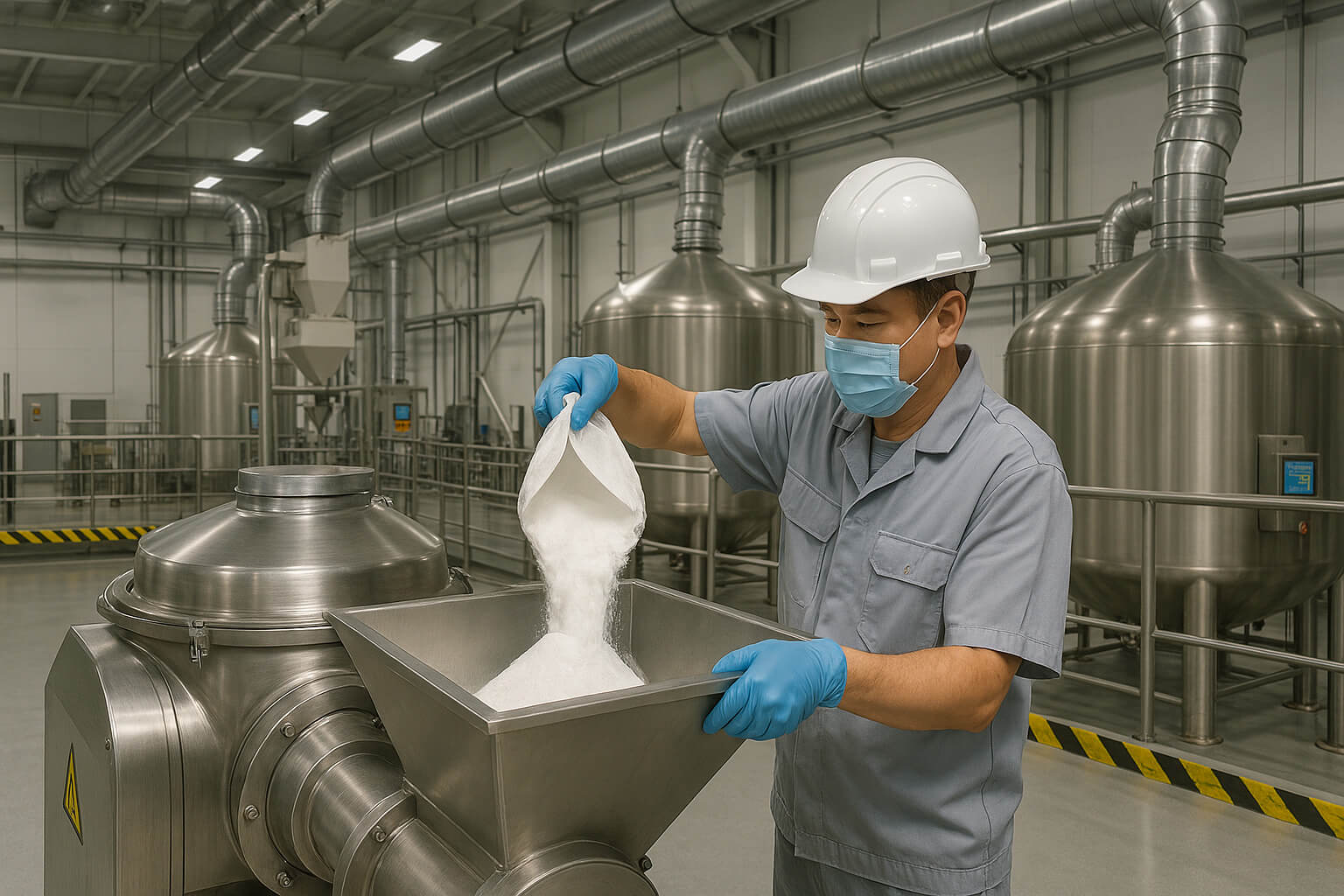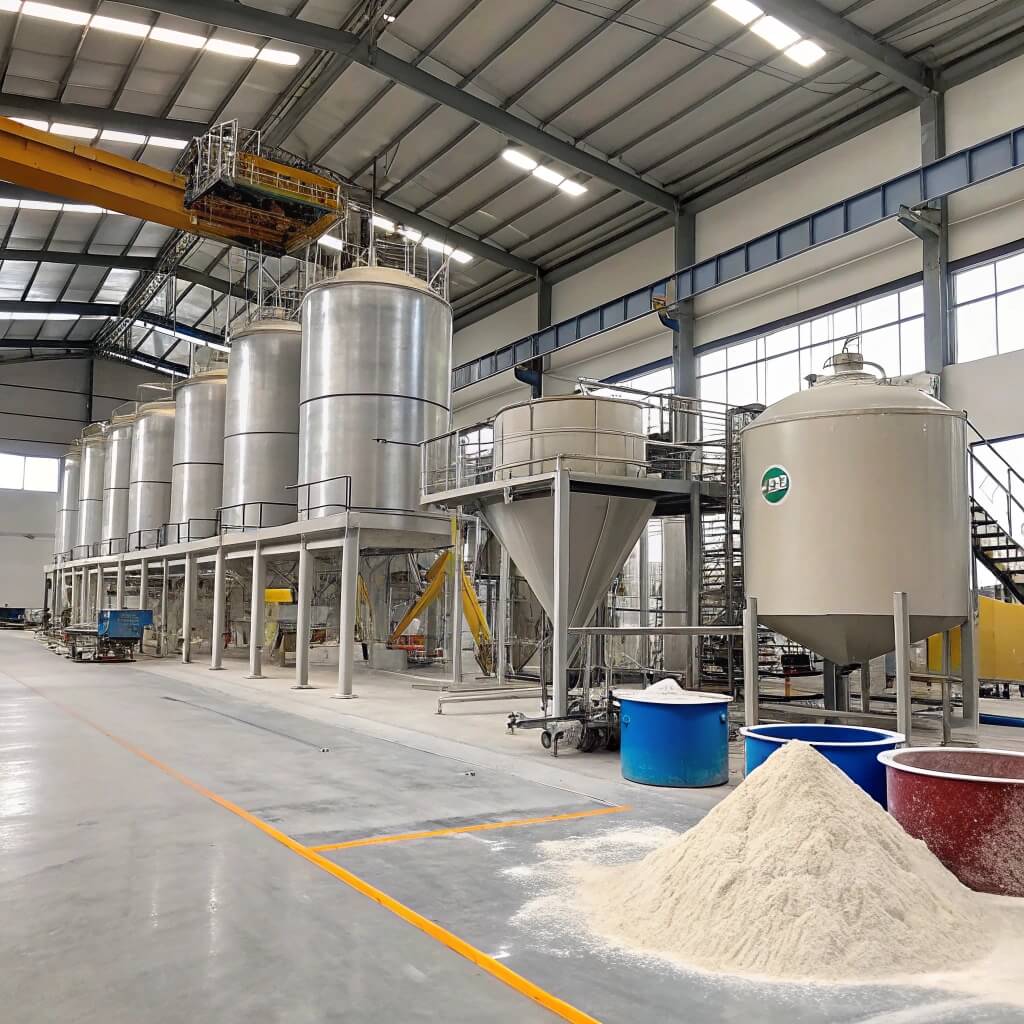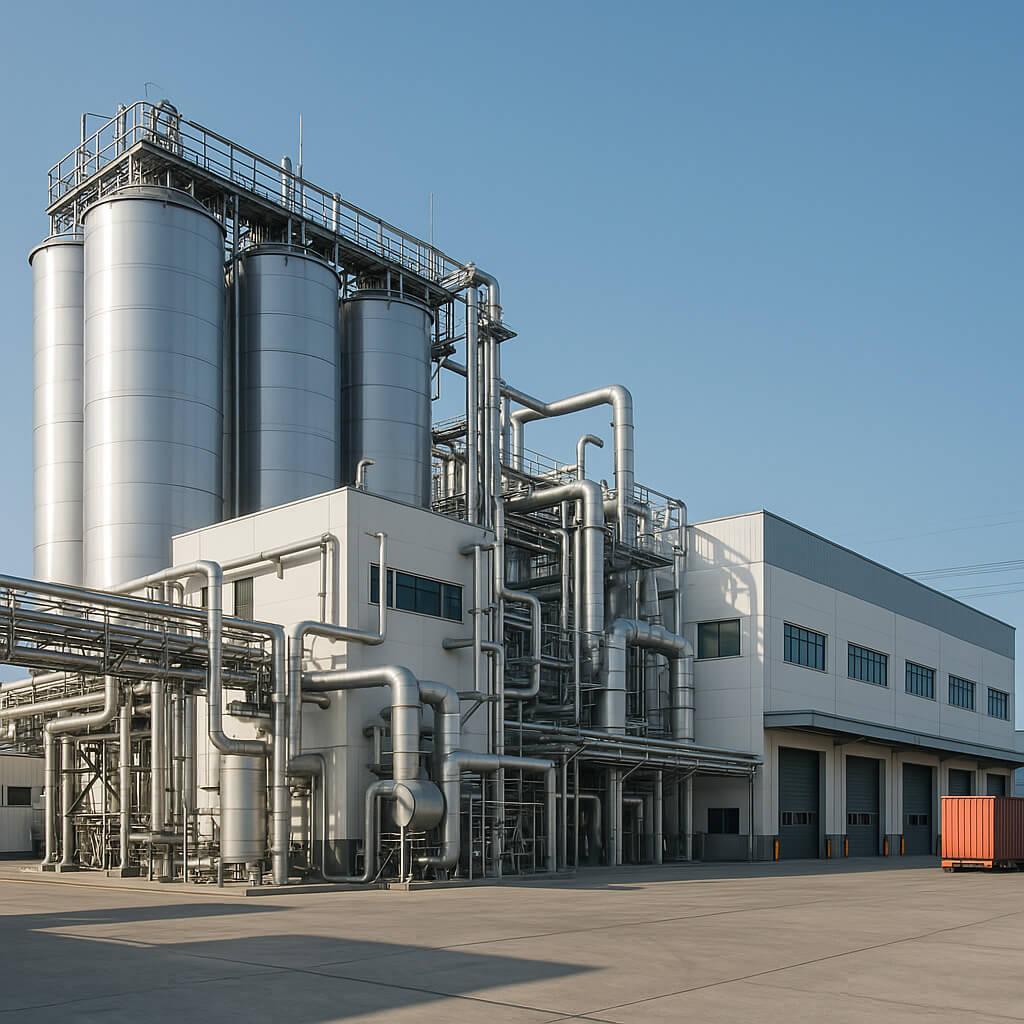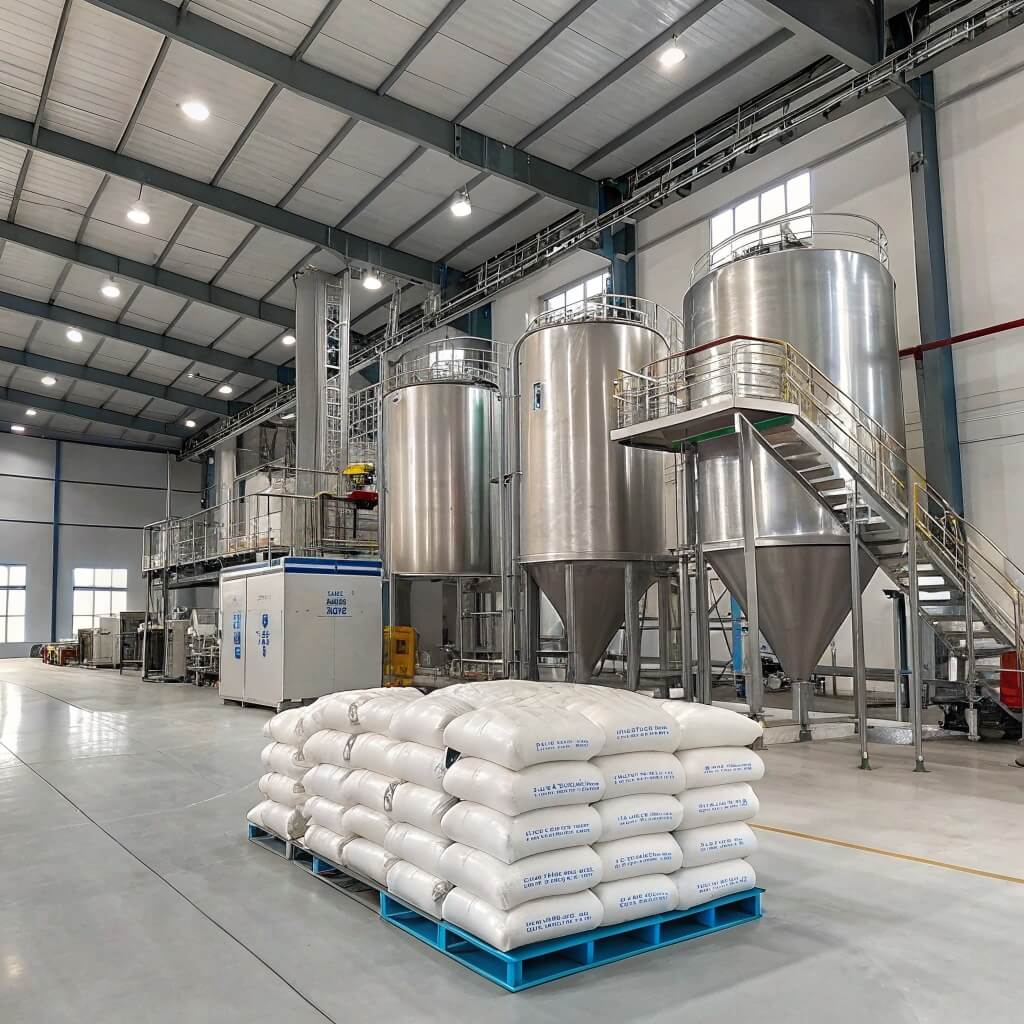Poorly bonded tiles slip, crack or detach, causing costly repairs and damaged customer trust.
HPMC (Hydroxypropyl Methylcellulose) serves as a crucial water-retention agent, workability enhancer, and open time extender in modern tile adhesives. This cellulose ether dramatically boosts bond strength while adding sag resistance, slip control, and application comfort.

Factory worker adding premium HPMC powder to a tile adhesive mixture in a controlled production environment, highlighting the precise measurement needed for quality formulations.
Our decade-long work with global construction brands shows that tile adhesive performance hinges on correct HPMC selection. Let's look at what makes this polymer so vital to your tile adhesive success.
What makes HPMC essential in modern tile adhesive formulations?
Project demands grow but application time shrinks. Workers need gap-proof bonds.
HPMC creates a moisture barrier between the adhesive and porous surfaces, preventing premature water loss. This controlled setting process gives installers extra working time while maintaining strong bonds with all tile types—porcelain, ceramic, natural stone, or glass.
When we test tile adhesives at our labs, products without proper HPMC content fail basic vertical slip resistance tests and show weak bonding, mainly on high-absorption substrates. Our data confirms that adding 0.2-0.3% HPMC to dry mix formulations transforms ordinary mortar into premium-grade adhesive with superior workability.
The open time of standard cement-based adhesive typically lasts 10 minutes. Our test results show that with 0.25% HPMC addition, open time extends to 20-30 minutes. This doubled working window means larger areas can be applied at once, boosting job efficiency while still achieving maximum bond strength.
Modern tile installations face tough challenges—large format tiles, heated floors, wet areas, outdoor applications—all demand more from adhesives. HPMC addresses these needs by forming a water-retaining gel network that keeps moisture available for complete cement hydration even on hot days or with porous substrates. The polymer's thickening action also prevents sagging of heavy tiles during installation.
How does HPMC improve the performance of tile adhesives?
Tiles fall. Bonds break. Clients complain. Repeat business vanishes.
HPMC transforms regular cement-based adhesives into high-performance systems by creating a perfect balance of water retention, workability, and controlled curing. This makes the adhesive stay moist longer for proper cement hydration while ensuring strong bonds with both porous and non-porous surfaces.
We test adhesive formulations daily and consistently find that HPMC-enhanced products offer superior performance across multiple key metrics. Our vertical slip testing shows adhesives with 0.25-0.3% HPMC maintain position even with heavy tiles, while control samples without HPMC fail immediately. Water retention tests confirm HPMC-containing adhesives keep over 95% of mix water available for proper curing compared to just 70% in standard formulations.
HPMC helps tile adhesives achieve extended open time while maintaining high tensile strength after full cure. Most competitive adhesives without proper HPMC content show drastic strength reduction when tiles are placed after 15+ minutes, a common reality on job sites. We find that correctly dosed HPMC formulations maintain over 90% of their bond strength even when tiles are placed after 25 minutes.
The practical benefits translate directly to the job site: fewer callbacks, less wastage, happier installers, and stronger finished installations. Most importantly, HPMC-enhanced adhesives reduce the risk of tile failure under thermal cycling, moisture exposure, and physical loads—extending the service life of the entire installation.
What are the technical functions of HPMC in tile adhesive systems?
Cement dries too fast. Water evaporates. Bonds fail before they form.
HPMC creates a protective colloid that controls water mobility within the adhesive mass, preventing rapid moisture loss and ensuring complete cement hydration. This cellulose ether also provides rheological control, turning ordinary mortars into thixotropic adhesives that spread easily but resist sagging.
Our lab testing throughout production batches reveals HPMC's multiple actions within adhesive systems. First, it forms a temporary gel structure that holds water against capillary suction from porous substrates. Second, it modifies the flow behavior, making adhesives spread easily under trowel pressure but recover structure when at rest. Third, it creates microscopic air voids that improve deformability, allowing adhesives to accommodate substrate movement.
The chemical mechanism involves HPMC molecules forming hydrogen bonds with water molecules, creating a three-dimensional network that slows water migration. This temporary scaffolding works alongside cement particle hydration, gradually releasing water as needed rather than allowing rapid drying. Our formulations use HPMC with specific DS (degree of substitution) values that optimize this water-retention capacity for different application environments.
HPMC Technical Effects in Tile Adhesive
| Función | Mechanism | Practical Benefit |
|---|---|---|
| Retención de agua | Hydrogen bonding with water molecules | Extended open time, complete cement hydration |
| Rheology Control | Thixotropic gel formation | Easy application, no-sag performance |
| Air Entrainment | Microscopic stable air voids | Improved flexibility, freeze-thaw resistance |
| Formación de películas | Surface barrier creation | Reduced water loss, better curing |
| Cement Dispersion | Steric hindrance between particles | Improved homogeneity, fewer weak spots |
For exterior applications, we recommend HPMC grades with higher viscosity (45,000-65,000 mPa·s) at 0.25-0.3% dosage to combat rapid drying in hot or windy conditions. Indoor applications can use medium viscosity grades (28,000-35,000 mPa·s) at slightly lower dosages to balance workability with cost-effectiveness.
How does the grade and dosage of HPMC affect tile adhesive quality?
Wrong viscosity causes failures. Incorrect dosage wastes money. Adhesive separates under the trowel.
HPMC grade selection directly impacts workability, open time, slip resistance, and cost-efficiency of the final adhesive. Higher viscosity grades (60,000+ mPa·s) provide excellent water retention and sag resistance but require careful dosing to maintain spreadability, while medium grades offer balanced performance for most applications.
We manufacture HPMC across viscosity ranges from 5,000 to 200,000 mPa·s specifically for construction applications. Our experience working with tile adhesive manufacturers worldwide shows that viscosity selection should match both application demands and regional climate conditions. Hot, dry environments benefit from higher viscosity grades that retain water longer, while moderate climates can use medium viscosity products effectively.
The dosage rate creates another critical balance point. Underdosing leads to poor water retention, short open time, and weak bonds. Overdosing increases cost and can cause excessive air entrainment, reducing final strength. Our technical team frequently helps manufacturers optimize this balance through tailored testing programs focusing on specific performance requirements.
For standard C1-class tile adhesives (according to EN 12004 standards), we typically recommend 0.20-0.25% HPMC content by weight of dry mix. Premium C2-class adhesives usually contain 0.25-0.35% HPMC, while specialized systems for large format tiles may require up to 0.4% HPMC to maintain extended open time and prevent skinning under challenging conditions.
The substitution degree (DS) and molar substitution (MS) of HPMC also influence performance characteristics. Products with higher methoxyl content dissolve faster and provide stronger initial thickening effect, while those with balanced hydroxypropyl groups offer better delayed water retention. We offer customized DS/MS ratios to match specific regional cement types and application conditions.
Why is HPMC preferred over other additives in polymer-modified tile adhesives?
Alternative additives fall short. Other polymers cost more. Formulations get complex.
HPMC outperforms competing additives through its unique combination of water retention, controlled rheology, and compatibility with cement chemistry. Unlike other cellulose ethers or synthetic polymers, HPMC provides multiple benefits in a single additive while avoiding negative interactions with cement hydration or other system components.
We regularly test alternative additives against our HPMC products and find consistent advantages. Compared to methyl cellulose (MC), our HPMC products dissolve more quickly and completely during mixing, avoiding fisheyes and lumps that plague many formulations. Compared to synthetic alternatives like polyacrylamides, HPMC offers superior water retention with less impact on final strength development.
The chemical structure of HPMC, with both methyl and hydroxypropyl substitutions, balances water solubility with delayed dissolution behavior. This creates ideal working properties that other additives cannot match. The hydroxypropyl groups improve cement compatibility and thermal gelation properties that enhance the water retention mechanism at elevated temperatures, a critical advantage for warm weather applications.
Field testing across thousands of real-world job sites confirms that HPMC-containing adhesives maintain consistent performance across varying conditions. This reliability reduces the need for season-specific formulations or regional adaptations that complicate manufacturing and distribution. Our customers report fewer technical support calls and warranty claims when using properly formulated HPMC-modified systems compared to alternatives.
HPMC also forms beneficial synergies with polymer latex additives like VAE or acrylic dispersions in high-performance adhesives. The combination enhances both fresh properties (workability, open time) and cured properties (flexibility, adhesion strength) beyond what either component could achieve alone. This compatibility makes HPMC the preferred cellulose ether for modern polymer-modified adhesive systems designed for demanding applications.
What factors should formulators consider when selecting HPMC for tile adhesives?
One-size solutions fail. Climate conditions vary. Application techniques differ.
Formulators should evaluate viscosity, substitution degree, particle size, and dissolution rate when selecting HPMC. These parameters must align with the intended application method, regional climate, tile type, and substrate characteristics to achieve optimal performance without unnecessary cost.
We manufacture HPMC with controlled viscosity ranges and substitution patterns specifically optimized for different tile adhesive applications. Our technical data shows that molar substitution (MS) strongly influences delayed water retention properties. Products with MS values between 0.13-0.18 typically provide the best balance of immediate thickening and extended water retention for most tile adhesive applications.
Particle size distribution affects dissolution speed during mixing, with finer grades dissolving faster but sometimes causing lumping if not properly dispersed. For most dry-mix tile adhesives mixed on site, we recommend standard 80-mesh products that provide balanced dissolution without requiring special mixing procedures. Pre-blended factory mortars may benefit from finer grades when rapid mixing is essential.
The chemical stability of HPMC under alkaline conditions makes it ideal for cement-based systems. Our HPMC products maintain performance even at high pH levels (12+) common in fresh cement mixes. This stability allows consistent adhesive performance throughout the working period without degradation that can affect some alternative additives.
The addition level must balance technical requirements with cost considerations. For standard residential tile applications, we typically recommend 0.25% HPMC content by weight of dry mix. This provides good water retention and workability without excessive cost impact. High-performance systems for commercial applications often use 0.30-0.35% to extend open time and enhance slip resistance with large format tiles.
Technical support during formulation development plays a critical role in success. Our laboratory offers customized testing programs to evaluate HPMC performance in specific formulations under various conditions. This collaborative approach ensures optimal additive selection rather than relying on generic recommendations that may not address unique formulation challenges.
Preguntas frecuentes
¿Cuál es el uso de HPMC en la formulación?
HPMC acts as a water-retention agent, rheology modifier, and workability enhancer in tile adhesive formulations. It forms a protective gel that prevents premature water loss while improving spreadability. At 0.2-0.3% dosage, HPMC extends open time from 10 to 30 minutes and boosts bond strength by ensuring complete cement hydration.
What is HPMC for tiling?
For tiling applications, HPMC creates thixotropic adhesives that spread easily yet resist sagging. It prevents moisture loss to porous tiles and substrates, extends working time, and improves vertical slip resistance. This cellulose ether enables proper adhesive curing even under challenging conditions, making it essential for professional tiling systems.
What is the function of HPMC chemically?
Chemically, HPMC molecules form hydrogen bonds with water, creating a temporary three-dimensional network that controls water mobility within cement mixtures. The methyl groups provide initial water solubility, while hydroxypropyl substitutions enhance cement compatibility and delayed dissolution. This structure forms a protective colloid that regulates cement hydration for optimal strength development.
¿Cuáles son los beneficios del HPMC?
HPMC benefits include extended open time (20-30 minutes versus 10 minutes for unmodified adhesives), improved vertical slip resistance, enhanced flexibility, and stronger final bond strength. It increases water retention by 25-30%, enabling proper curing even on highly absorbent substrates. HPMC also creates comfortable workability that reduces installer fatigue and improves application quality.
Conclusión
The strategic addition of HPMC transforms basic cement mixtures into high-performance tile adhesives by controlling water mobility, enhancing rheology, and extending open time. Our extensive testing confirms that properly selected HPMC grades at 0.25-0.35% dosage levels dramatically improve both application properties and final performance across diverse installation scenarios.
The right HPMC selection balances multiple factors: viscosity requirements, regional climate conditions, substrate absorption, and tile characteristics. This careful matching creates systems that work reliably across varying job site conditions, reducing callbacks and failures while enhancing installer productivity and satisfaction.
Contact our Morton technical team for customized HPMC recommendations based on your specific tile adhesive formulation needs. Our laboratory can help optimize your system's performance through tailored testing and practical application guidance.




